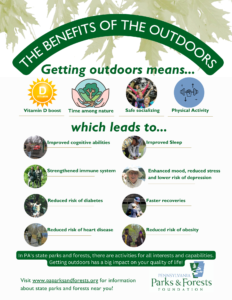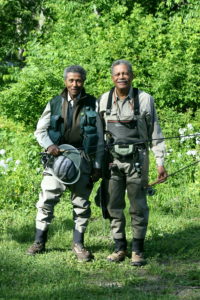The great outdoors has been a constant place of relaxation and comfort for all. Especially in recent years, people are flocking to nature for a safe haven—and getting outside is essential for mental and physical health. However, not everyone has equitable access to the outdoors and the benefits of nature that many of us take for granted. Older adults, specifically residents of long-term care facilities, often rely on visitors, staff, and volunteers to be able to spend time in the natural environment.
The Department of Conservation and Natural Resources (DCNR), through its strategic initiatives and planning (including its recent outdoor recreation plan entitled Recreation for All – see https://www.dcnr.pa.gov/Recreation/PAOutdoorRecPlan) is actively seeking to advance equitable outdoor recreation opportunities for all Pennsylvanians, including older adults who may not readily have access to nature.
DCNR is working to strengthen connections with the health and wellness community, design and construct more ADA-accessible trails and parks, and proactively engage and serve historically underserved populations through partnerships with outdoor and conservation non-profits, older adult advocates, and more.
As the world’s population ages rapidly (Levinger et al., 2022) and a staffing crisis grows amidst the global pandemic, the barrier between residents of long-term care facilities and the outside world is only becoming stronger. Increasing public awareness around the health benefits of nature and connecting older adults to the natural environment through outdoor recreational therapy and programming is more necessary now than ever.
 The correlation between nature and the well-being of humans, physically and mentally, has heavy support. Interactions with the physical environment are incredibly restorative, providing sensory stimulation that can reduce stress, lower blood pressure, and help facilitate recovery after surgery or injury.
The correlation between nature and the well-being of humans, physically and mentally, has heavy support. Interactions with the physical environment are incredibly restorative, providing sensory stimulation that can reduce stress, lower blood pressure, and help facilitate recovery after surgery or injury.
These effects can be felt from even just a window view of nature. In a 1984 study, patients who were able to see outside from their hospital windows had an accelerated and easier recovery experience after surgery than patients without a nature view.
Additionally, time and physical activity outdoors can help to improve sleep patterns with the bright light exposure from the sun that interacts with the circadian rhythm (Astles, 2015; Connell et al., 2007). Physical healing properties of nature apply to all ages, but regular activity in nature can prevent many chronic diseases and help older adults live longer (Carman, 2011).
The cognitive benefits of being in nature are equally striking. Long-term care residents living in a facility with access to outdoor garden space reported feeling free and invigorated after having the chance to learn new things about gardening while spending quality time with their families outdoors (Slavens, 2008).
For many older residents, the natural environment has always been an important part of their daily activities and lives. The outdoors was the best place to enjoy the activities they love whether it was sports, fishing, gardening, or any of the other limitless options for fun and socializing. Outdoor experiences and programming can offer the opportunity to enjoy beloved hobbies and interests while maintaining some level of continuity in their lives.

Mona Handot – Oil Creek State Park
Socializing outdoors provides older adults with a renewed sense of joy and purpose. Social interaction is pivotal to mental health, as illustrated by the COVID-19 pandemic. As many as 77% of long-term care facility residents experience depression because of social isolation, a statistic preceding COVID (Fitzsimmons, 2011).
Many older adults in long-term care rely on family or community supports to get outdoors that may not always be present. The issue got exponentially more challenging as facilities took the necessary precautions to prevent the spread of COVID to a high-risk population (Hwang et al., 2020). As life begins to return to a hopeful new normal, there are still other barriers to getting older adults outdoors that must be considered when planning time in nature.
Residents may be confined to geri-chairs or require wheelchairs and other assistive devices for mobility, which can make reaching outdoor space more difficult on their own (Astles, 2015). Those who lack mobility often require support systems such as staff, family, or volunteers. Some facilities lack easy access to nature. Transportation of residents from facilities to outdoor settings may be challenging or not an option at all with inadequate funding, access to ADA-accessible vehicles, staff and volunteer capacity, etc. and many are unaware of the resources that exist to help alleviate these issues.
These represent the most significant barriers to connecting older adults in long-term care facilities to the outdoors. And for those who do get outside, there is no guarantee that these spaces—especially those that are off-campus—will be ADA-accessible for all residents to enjoy. It’s important for facilities to tailor outdoor connections to the needs and abilities of their residents as much as possible. They can start small and still bring great benefits to the people who receive them, thanks to the power of nature.
Overall suggestions for outdoor recreational therapy and programming for older adults in long-term care facilities range from small nature-related crafts to specially built gardens and walking paths on facility grounds (Carman, 2011). Residents and their families alike note feeling purposeful doing activities like watering plants, birdwatching, stargazing, and weeding. Garden programs that encompass these activities contributed to needed social interaction and reduced feelings of loneliness (Astles, 2015).
Facilities should consider bringing regular programming such as board games, puzzles, bingo, and crafts outside when weather permits. Other potential activities that offer opportunities to absorb the benefits of the natural environment include fishing, forest bathing, and visiting a local or state park.
Transportation from a facility to a state park can be organized with various organizations, including the Pennsylvania Parks and Forest Foundation through their Wilderness Wheels Transportation Scholarship Program (apply here: https://paparksandforests.org/our-work/education/wilderness-wheels-transportation-scholarships/).
Visiting a local or state park could further benefit residents by coordinating with an environmental educator and Friends Groups (find them here: http://www.paee.net/find-ee-near-me.html; https://paparksandforests.org/friends-groups/) who can help offer programming and lead nature-based activities.
Elements of nature and its benefits also easily can be brought indoors. With planning by facilities, external programming from environmental educators, recreational therapists, etc. can be tailored for connection to the natural environment from within the facility. Residents can see slideshow presentations with pictures from the outdoors and feel the same positive effects of lowered stress and blood pressure that they would get from sitting outside (Astles, 2015). Virtual reality technology can bring an even more realistic feeling to an indoor nature activity. Snoezelen-style rooms are also rising in popularity for older adults with dementia for calming and sensory development purposes and could be outfitted with visual, tactile, auditory, and olfactory stimuli of nature for a more inclusive and holistic experience.
The opportunities to expand access to the natural world are endless.
In the short-term, the most pressing steps in connecting older adults in long-term care facilities to the outdoors are raising awareness around the importance of time and recreational therapy outdoors for aging Pennsylvanians, as well as educating all those who will be bridging the gap between facility residents and nature.
The natural environment plays an essential role in maintaining physical and mental wellness, but these benefits are being lost on an underserved population that needs them due to circumstances beyond their control. Anyone from facility staff, volunteers, and residents’ visitors who get involved in any capacity to try to connect older adults in long-term care facilities to the outdoors not only makes a huge difference in these individuals’ lives and well-being but helps to ensure that the comfort of the outdoors is truly for all.
Discover more resources on the benefits of outdoor recreation on the Pennsylvania Parks and Forests Foundation’s Publications page: https://paparksandforests.org/about-us/publications/#PPFF-Skill-Builders
Written by Madison Short, Pennsylvania Department of Conservation & Natural Resources Office of Policy and Planning
References
Astles, B. (2015). The Impact of Outdoor Environments on Health and Well-being of Residents in Long-term Care Facilities: A Review of the Literature.
Carman, J. (2011). Elders’ lifelong connection with the natural environment. Educational Gerontology, 37(6), 488–498. https://doi.org/10.1080/03601277.2011.570203
Connell, B. R., Sanford, J. A., & Lewis, D. (2007). Therapeutic effects of an outdoor activity program on nursing home residents with dementia. Journal of Housing For the Elderly, 21(3-4), 194–209. https://doi.org/10.1300/j081v21n03_10
Fitzsimmons, S. (2011). Evidence-based practice guideline: Wheelchair biking for the treatment of depression. Journal of Gerontological Nursing, 37(7), 8–15. https://doi.org/10.3928/00989134-20110602-03
Hwang, T.-J., Rabheru, K., Peisah, C., Reichman, W., & Ikeda, M. (2020). Loneliness and social isolation during the COVID-19 pandemic. International Psychogeriatrics, 32(10), 1217–1220. https://doi.org/10.1017/s1041610220000988
Levinger, P., Goh, A. M., Dunn, J., Katite, J., Paudel, R., Onofrio, A., Batchelor, F., Panisset, M. G., & Hill, K. D. (2022). Exercise intervention outdoor project in the community—enjoy program for independence in dementia: A feasibility pilot Randomised Controlled Trial Study Protocol. Pilot and Feasibility Studies, 8(1). https://doi.org/10.1186/s40814-022-01027-x
Slavens, S. (2008). The Psychosocial Benefits of Exposure to Natural Settings in Long-term Care: An Evaluation of the Wellness Garden Program at Glacier Hills Retirement Community. Journal of Therapeutic Horticulture.




